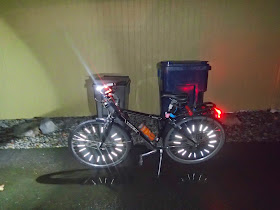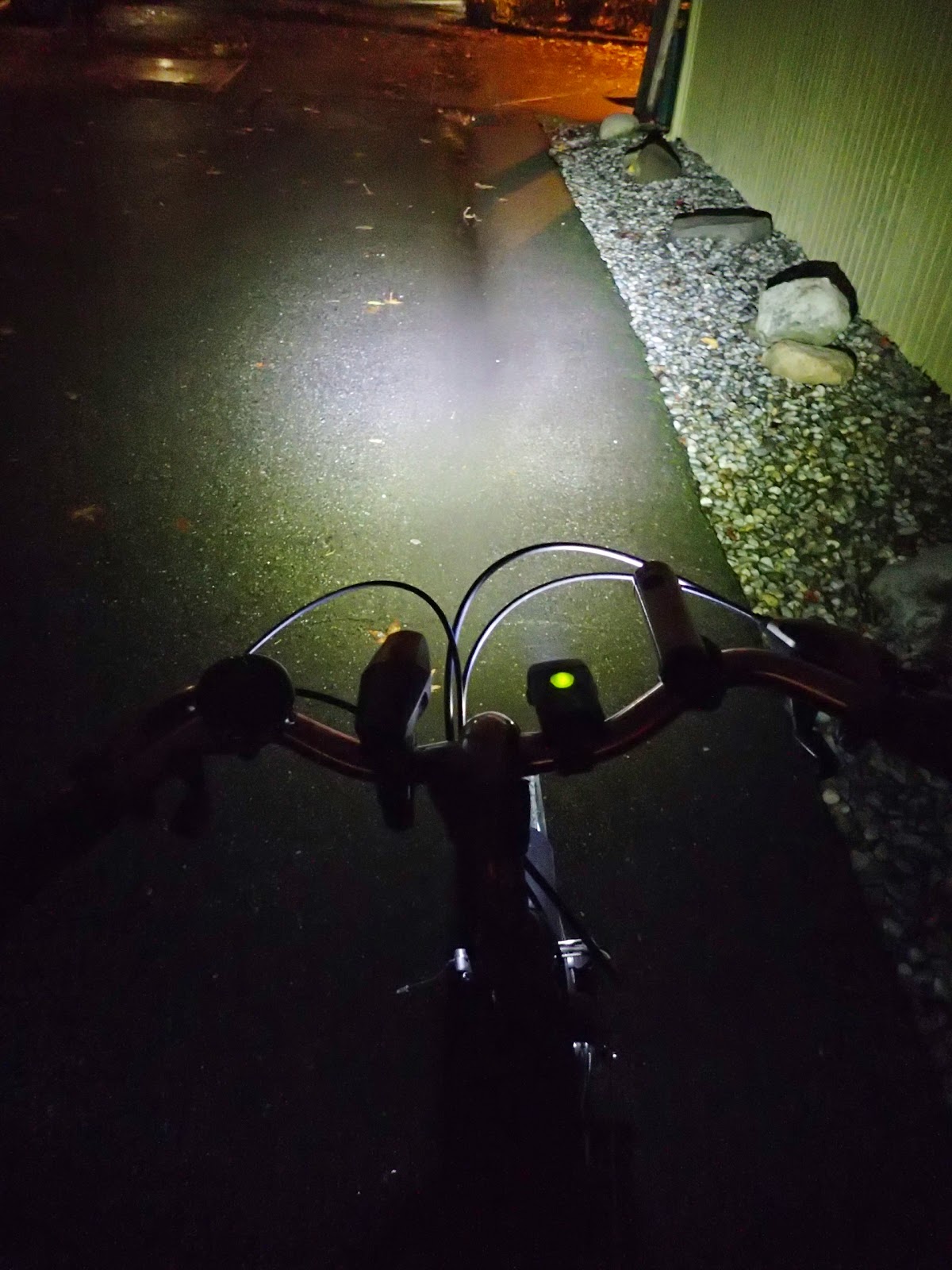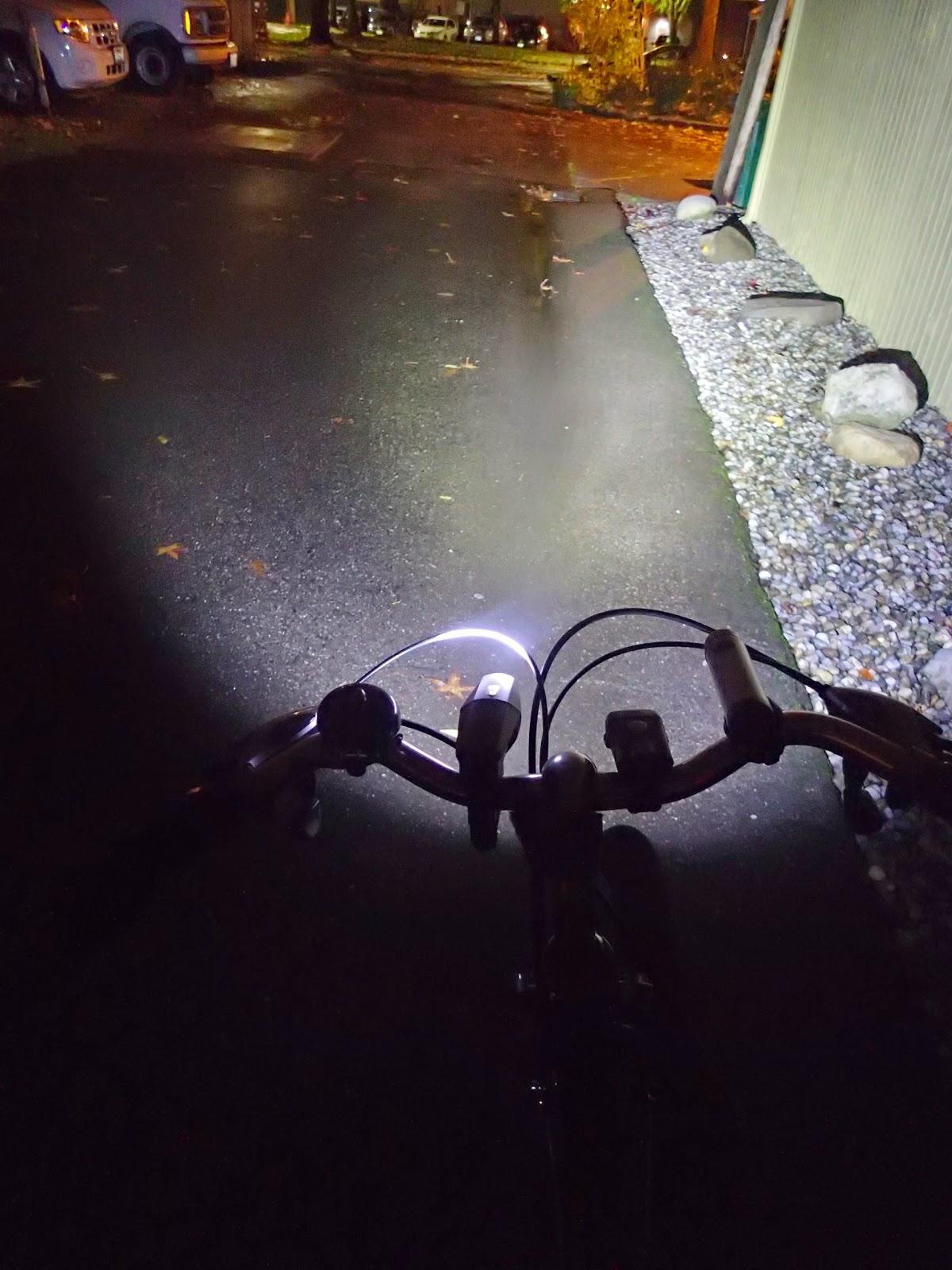Faraday Bicycles is a fairly new company who make an electric assist bicycle called the
Faraday Porteur. While Faraday doesn't have a network of dealers, they do have a few demo bikes available at a few bike shops around the country. My friends at
G and O Family Cyclery are one of the shops lucky enough to have a Porteur and I got to spend a cool November day in Seattle riding the bike around the city. In this post I'll do my best to sum up the experience of riding the bike.
The porteur rack is quite handsome. It's rated for 10 kilograms and unlike a front basket that turns with the handlebars and fork, the rack is attached to the frame of the bike. The rack is an optional accessory for the bike and is fairly easy to take on and off. On the demo bike, the Faraday's headlight is mounted on the stem and thus its beam could be blocked by a big load on the rack, but if you intend on keeping the rack on the bike permanently, the wiring for the light can be rerouted to allow mounting the headlight under the rack.
This is the control for the e-assist. The little e-ink bar graph read 3/4 full when I picked the bike up. The guys at G and O also loaned me one of the surprisingly compact chargers for the bike (it comes with two). I stuffed the charger into my backpack. Davey at G and O commented that he's surprised that the Faraday folks don't equip the bike with a fancy frame case for the charger.
I was curious how much the bike weighed and the guys at G and O don't have a scale ("We should get a scale" was the comment, followed by "Kathleen at FreeRange has one.") so I strapped my pack to the porteur rack and headed off to the Fremont neighborhood to see Kathleen. It's mostly a downhill run from Greenwood to Fremont, so I really didn't engage the e-assist except for a couple of quick starts from stop lights and little climbs to make sure everything was working.
Kathleen is a very savvy bike person and even she didn't notice right away that the Faraday is electric. That's the most striking thing about it, it looks, rides and feels like a non-assisted bike. The bike is heavier than a non-electric bike, of course a motor and batteries don't come for free, but the balance of the bike is quite wonderful. The rear of the bike houses a Shimano Alfine 8 speed hub, the batteries are concealed inside the bike frame and the electric motor is inside the front hub. In my job as a bike mechanic I've often had to wrestle unwieldy e-bikes into a repair stand and in general it's like trying to hoist a metal pig. Not so with the Faraday, this is a bike I could carry up a set of stairs or easily hoist onto a bike rack.
The Faraday does weigh more than the 30 pounds Kathleen's scale is rated for so the scale's dial wrapped around and settled on 17 pounds. 30+17=47 pounds which seemed heavier than my heft guess and I think the wrapped scale over reported the bike's weight. Faraday's specs list the bike at 39 pounds and I could believe that the rack adds another 5 pounds so that would make the combo more like 44 pounds. Whatever the case, the bike doesn't feel like a heavy bike and more importantly, it rides like a normal bike.
Kathleen had to test the bike out. The grin is an automatic side effect of engaging the e-assist.
Here's a good shot of the bike. My pack is strapped to the front rack. The leather pouch is a very fancy holder store the rack bungie cords when they're not in use. The fenders are bamboo and look pretty although I'd prefer something longer, with more curvature around the tire for better water deflection. This is a medium size frame and 5'6" me was perfectly comfortable on the bike. The double leg kickstand is standard equipment.
Here's the bike looking pretty at the Seattle ship canal.
The bars are very comfortable.
Of course a bike this fancy comes with a Brooks saddle. The rear panel on the frame has the power switch (top), LED lights which serve as both tail lights and charging indicators (middle) and the plug for the charger (bottom).
If you were riding behind this bike in the rain, you'd wish this fender was a bit longer.
I really got to like the porteur rack. The load up front didn't seem to alter the handling of the bike.
The bike gets lots of attention. Strangers would stop and comment on the bike, noting how pretty it is or asking about the front rack. Nobody noticed that it is electric.
By the way, you can click on any of the pictures in this post to embiggen them.
Another shot of that very comfy Brooks saddle.
Let's talk a bit about the electronics. The Faraday Porteur comes with a 250W motor built into the front hub and a custom 240Wh battery pack concealed inside the frame. I'd wondered about the replace-ability and durability of the batteries but the folks at
Faraday assure me that the high quality lithium batteries should last through several years of charging cycles and when they ultimately do need replacing, it's an easy job for a local shop. They estimate current battery replacement cost at $400, but battery tech is getting better year by year and the prices are dropping. The batteries power both the bike's lights and it's motor. When the bike is switched on, the lights are on. The integrated lights are nice, bright LEDs.
The e-assist is what really makes the Faraday special. A left hand control contains the e-ink display showing how much power is left in the batter pack and a little thumb switch controlling how much of an assist the motor will add to your pedalling. The switches three positions are OFF (no assist), ON (normal assist) and BOOST (which is additively fun).
Here's the number one thing I noticed about the Faraday Porteur. It rode so well as a bike that on flat sections or going downhill, I'd wouldn't turn on the e-assist. Unlike many other e-bikes I've ridden, the Porteur didn't feel burdened by the weight of its motor and batteries. It felt like a bike so having a dead battery wouldn't be a disaster, you'd just pedal home. This makes it pretty much impossible to answer the "what's the range" question on this bike. It would be odd to ride it with the e-assist on all the time.
But I was intent on testing the bike, so I consciously looked for steep hills (plentiful in Seattle) and engaged the e-assist to give a turbo boost as I pulled out from stoplights. The boost only assists your pedalling, this is not a bike where you coast and let the motor pull you along.
So in my quest for hills I picked nasty ones. It's hard to convey grade in a photograph, but this wall along the sidewalk of 23rd Avenue climbing up from Montlake gives you a bit of idea of the grade. I spent the day in counterpoint to my usual, pick the gentle slopes strategy and instead played around on various nasty hills.
My missions for the day included visiting various bookstores and having lunch and a bike ride with my friend Mark Canizaro.
After going up and over various climbs on Seattle's Capitol Hill. I pulled up to Mark's place. Literally on the last 1/2 block of the climb to Mark's, I depleted the last of the battery.
While Mark and I had a bit of lunch and chatted about various things involving bikes, books, philosophy and darn near everything else, we charged up the bike.
We let the bike charge for 45 minutes and then headed out. The battery meter was reading 50%
Of course we did more climbing.
This picture basically shows off two pieces of art. One of them is also extremely fun to ride.
Mark managed to get a few shots of me on the bike.
It was a lovely day for riding. On one steep climb a passerby commented "You don't even look like you're working!" He wasn't wrong.
Here's an example of the Faraday Porteur in front of a house that is undoubtedly owned by someone (not me!) that could easily afford a Faraday Porteur. In case you're wondering and haven't already surfed over to the Faraday page, this is not a cheap bike. The retail price is $3500, which is pretty much out of this bike mechanic's price range. But the more I rode the bike, the more I sensed that this bike is worth its price tag. Good engineering doesn't come cheap.
By the way, when you live in that fancy Seattle house, this is the view out your front door. It's normally not blocked by some dorky looking guy on a really nice bike.
Mark and I traded off with the Porteur as we made our way over to Bike Works in Columbia City. Mark's comment as he crested the wickedly steep 37th Street, "It's like having a ski lift attached the bike."
At Bike Works a couple of the mechanics took the bike for a spin, both returning with huge grins. Both Mark and I have 50+ year old ears and would swear that the Porteur's motor is silent but Homer's comment corrected our impression when he said, "Man, you can barely hear the motor!" So I guess the motor does make a tiny bit of noise.
At the bakery Mark and I sipped our drinks while I fielded more "nice bike" comments. I took a few more detail shots of the bike. Those are Shimano cable activated disk brakes and they work very well. The belt drive and Alfine hub make for a smooth, clean, quiet drivetrain.
The front motor is rather compact and attracts little attention.
Here's a shot of the e-assist controller. The e-ink gauge shows the battery at something under 50%.
The Shimano Alfine 8-speed shifter. Nice shifting and I found the gear range to be quite nice.
Mark and I rode up Lake Washington Boulevard, parting ways as he headed for home on Capitol Hill. I continued North to the University and then rode the Burke Gilman Trail over to Fremont and then up to G and O. At the end of the day I'd ridden 36 miles. I used up pretty much the last of my battery charge on the climb from Fremont to Phinney Ridge, so I feel I timed things just right.
The Faraday Porteur is an amazing bicycle. It's the only e-bike I've ridden that basically feels like a normal bike. It's a bike where the weight of the electronics are so well integrated into the bike, you can easily forget they are there. But when you engage the power assist, the bike becomes more than a bike. When you ride the bike without the e-assist, it feels like a very, very nice bike. When you engage the e-assist, it feels like flying.






















































